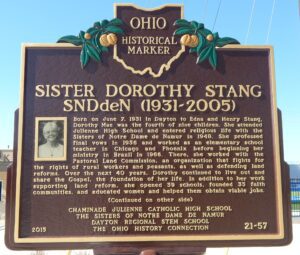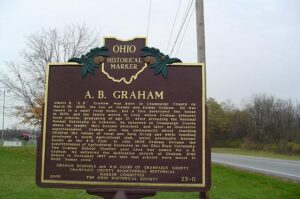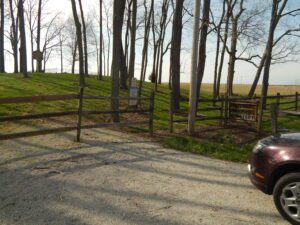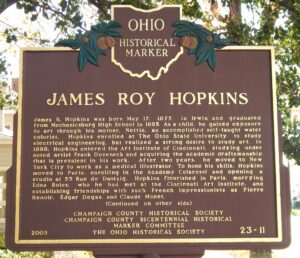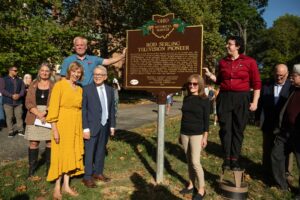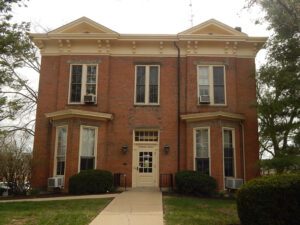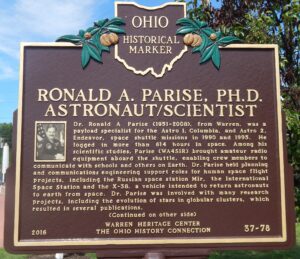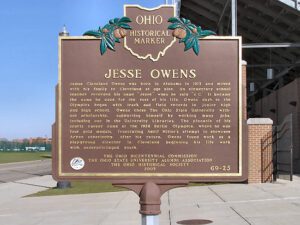, OH
Born on June 7, 1931 in Dayton to Edna and Henry Stang, Dorothy Mae was the fourth of nine children. She attended Julienne High School and entered religious life with the Sisters of Notre Dame de Namur in 1948. She professed final vows in 1956 and worked as an elementary school teacher in Chicago and Phoenix before beginning her ministry in Brazil in 1966. There, she worked with the Pastoral Land Commission, an organization that fights for the rights of rural workers and peasants, as well as defending land reforms. Over the next 40 years, Dorothy continued to live out and share the Gospel, the foundation of her life. In addition to her work supporting land reform, she opened 39 schools, founded 35 faith communities and educated women and helped them obtain viable jobs. (Continued on other side)
, OH
Albert B. “A.B.” Graham was born in Champaign County on March 13, 1868, the son of Joseph and Esther Graham. He was raised in a small rural home, but a fire destroyed the house in 1879, and the family moved to Lena where Graham attended local schools, graduating at age 17. After attending the National Normal University in Lebanon, he returned to Champaign County where he taught, then became principal, and later an innovative superintendent. Graham also was enthusiastic about teaching children the values of rural and farm living and while teaching developed a youth agricultural club, which eventually became known as the 4-H Club. In July 1905 Graham became the superintendent of Agricultural Extension at the Ohio State University. The Graham School District near Lena was named for A.B. Graham. He delivered the dedication speech at Graham High School in December 1957 and said that schools were meant to build “human souls.”
, OH
In the early years of the nineteenth century, a religious unrest known as the Second Great Awakening spread across much of the American frontier. Among the most influential of the evolving religious organizations were the Campbellites, or Disciples of Christ, founded in the 1820s by Thomas and Alexander Campbell. The Campbellite movement sought to “restore” New Testament Christianity by calling for a return to the primitive church revealed in the gospels. Campbellites denied creeds and oath-taking and rejected sectarianism. They believed in baptism by immersion and communion on Sundays. Followers also dealt with problems and transgressions of members within the church and did not use civil courts. They held a millennial view that professed human happiness and the belief that Christ would reign on earth for a thousand years. Believers spread this word to the pioneers of the Doty Settlement and elsewhere. By 1850, there were ninety Campbellite Churches in Ohio.
, OH
James R. Hopkins was born May 17, 1877, in Irwin and graduated from Mechanicsburg High School in 1895. As a child, he gained exposure to art through his mother, Nettie, an accomplished self-taught water colorist. Hopkins enrolled at The Ohio State University to study electrical engineering, but realized a strong desire to study art. In 1898, Hopkins entered the Art Institute of Cincinnati, studying under noted artist Frank Duveneck and acquiring the academic draftsmanship that is prevalent in his work. After two years, he moved to New York City to work as a medical illustrator. To hone his skills, Hopkins moved to Paris, enrolling in the Academy Colarossi and opening a studio at 55 Rue de Dantzig. Hopkins flourished in Paris, marrying Edna Boies, who he had met at the Cincinnati Art Institute, and establishing friendships with such French Impressionists as Pierre Renoir, Edgar Degas, and Claude Monet. [continued on other side]
, OH
Rodman Edward Serling (1924-1975) enrolled at Antioch College in 1946 following military service in World War II. He began college as a physical education major, but soon discovered writing as a way of working through his war experiences. As a student, he contributed short fiction to The Antiochian literary magazine, managed the student-run Antioch Broadcasting System, and wrote and produced award-winning radio dramas. In July 1948, Serling married classmate Carolyn “Carol” Kramer. Shortly after earning his degree in 1950, he took a copy writer job at Cincinnati’s WLW radio. Serling quickly focused on selling scripts to national television networks. After eight years in Ohio, he and his wife moved to Connecticut. He returned to Antioch after the third season of The Twilight Zone to teach writing, drama, and media during the 1962-1963 academic year.
, OH
Built by “Old Miami” University President Robert L. Stanton, D.D. (1810-1885) as his private home and president’s office, Stanton’s 1868 Italianate house faced University Square, and welcomed students and guests. The house retains its original symmetrical façade, enclosed portal, grand staircase, double parlors, parlor doors, marbleized slate mantels, and triangular bay windows. Stanton served as president from 1866-1871. Stanton’s son, Robert Brewster Stanton, MU ’71, famed civil engineer, lived here as an undergraduate. His Miami mentor, mathematics professor Robert W. McFarland (1825-1910), purchased the house in 1873. McFarland rented it while distinguishing himself at Ohio State University during Miami’s twelve-year closure, and then resided here while first president of “New Miami” (1885-1888) and until his death. McFarland’s daughter Frances and her husband Llewellyn Bonham sold the home to Miami in 1940.
, OH
Dr. Ronald A. Parise (1951-2008), from Warren, was a payload specialist for the Astro 1, Columbia, and Astro 2, Endeavour, space shuttle missions in 1990 and 1995. He logged in more than 614 hours in space. Among his scientific studies, Parise (WA4SIR) brought amateur radio equipment aboard the shuttle, enabling crew members to communicate with schools and others on Earth. Dr. Parise held planning and communications engineering support roles for human space flight projects, including the Russian space station Mir, the International Space Station and the X-38, a vehicle intended to return astronauts to earth from space. Dr. Parise was involved with many research projects, including the evolution of stars in globular clusters, which resulted in several publications. (Continued on other side)
, OH
James Cleveland Owens was born in Alabama in 1913 and moved with his family to Cleveland at age nine. An elementary school teacher recorded his name “Jesse” when he said “J.C.” It became the name he used for the rest of his life. Owens’ dash to the Olympics began with track and field records in junior high and high school. Owens chose The Ohio State University without scholarship, supporting himself by working many jobs, including one in the University Libraries. The pinnacle of his sports career came at the 1936 Berlin Olympics, where he won four gold medals, frustrating Adolf Hitler’s attempt to showcase Aryan superiority. After his return, Owens found work as a playground director in Cleveland beginning his life work with underprivileged youth.


